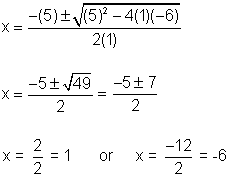 |
Blueprints for this Lesson: |
|
Quadratic Equations:
Quadratic equations are written in the form ax2 + bx + c = 0. Two of the methods that can be used to solve quadratic equations are factoring and the quadratic formula. Let's review the process by working out a couple of examples. As you will see, either method will result in the same solutions.
Method 1: Factoring
|
Method 2: Quadratic Formula
Notice the solutions for x are the same whether you factored or used the quadratic formula to solve. |
| Method 1: Factoring
3x2 + 2x - 1 = 0 (3x - 1)(x + 1) = 0 3x - 1 = 0 or x + 1 = 0 x =  or x = -1 or x = -1Now make sure to check your solutions. |
Method 2: Quadratic Formula
3x2 + 2x - 1 = 0, where a = 3, b = 2, and c = -1. Now substitute into the quadratic equation.  |
Now it's your turn to solve. You may use either method.
- x2 - 6x + 8 = 0
- 2x2 = x + 10 (hint: remember to write it in the form ax2 + bx + c = 0)
 Click here to check your work
Click here to check your work
Solving Equations that involve Ratios:
Problems that involve ratios can be easily solved using an equation. Look at the following examples.
- A boy broke his teacher's yardstick into three pieces that are in a ratio of
2:3:4. How long is each piece?
Solution: Write an equation using the variable x with each part of the
ratio. Since a yardstick is 36 inches long, we know that the sum of the
parts is 36 inches. The equation would look like this:
2x + 3x + 4x = 36
9x = 36
x = 4; therefore the lengths are 2(4) = 8in., 3(4) = 12 in., and 4(4) = 16 in.
Check your answer: 8 + 12 + 16 = 36
- A tree that was 56 feet tall was hit by lightning and is now in two pieces in a
ratio of 3:4. Find the length of each piece.
Solution:
3x + 4x = 56
7x = 56
x = 8; therefore the lengths of the two pieces are 3(8) = 24 ft., and 4(8) = 32 ft.
Check your answer: 24 + 32 = 56
Now you try one.
A is between C and T, and divides  into a ratio of 3:7 respectively. If CT = 142 inches, find CA and AT.
into a ratio of 3:7 respectively. If CT = 142 inches, find CA and AT.
Go to the assessment area and submit your "1.04H Segments" assignment. This is in addition to submitting the regular "1.04 Segments" assignment.



 0,
0,



